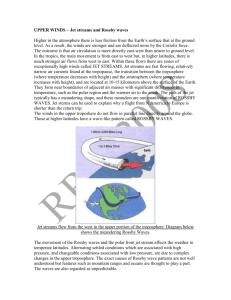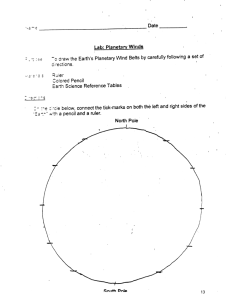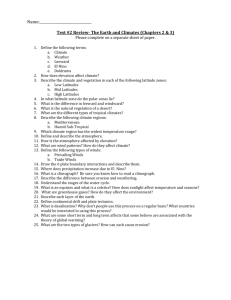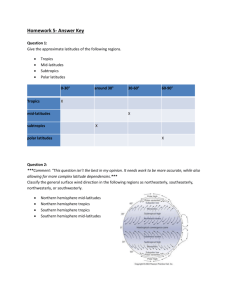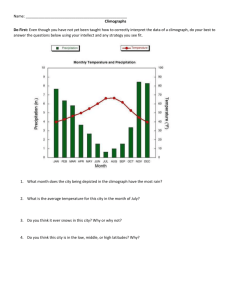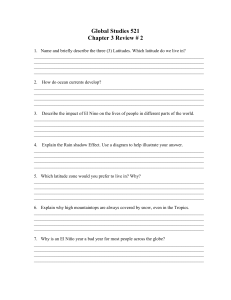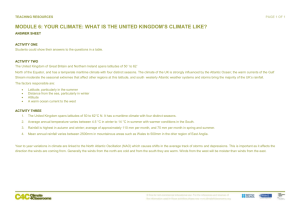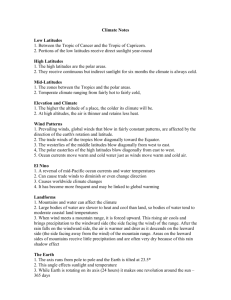global atmospheric circulation/rossby waves
advertisement
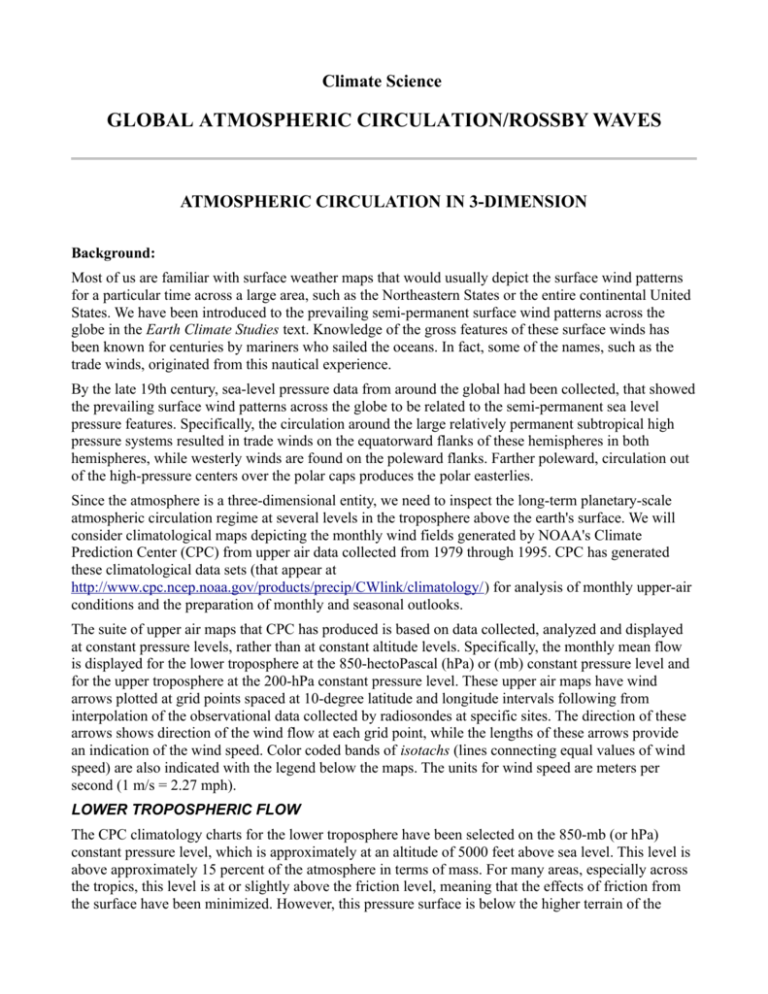
Climate Science GLOBAL ATMOSPHERIC CIRCULATION/ROSSBY WAVES ATMOSPHERIC CIRCULATION IN 3-DIMENSION Background: Most of us are familiar with surface weather maps that would usually depict the surface wind patterns for a particular time across a large area, such as the Northeastern States or the entire continental United States. We have been introduced to the prevailing semi-permanent surface wind patterns across the globe in the Earth Climate Studies text. Knowledge of the gross features of these surface winds has been known for centuries by mariners who sailed the oceans. In fact, some of the names, such as the trade winds, originated from this nautical experience. By the late 19th century, sea-level pressure data from around the global had been collected, that showed the prevailing surface wind patterns across the globe to be related to the semi-permanent sea level pressure features. Specifically, the circulation around the large relatively permanent subtropical high pressure systems resulted in trade winds on the equatorward flanks of these hemispheres in both hemispheres, while westerly winds are found on the poleward flanks. Farther poleward, circulation out of the high-pressure centers over the polar caps produces the polar easterlies. Since the atmosphere is a three-dimensional entity, we need to inspect the long-term planetary-scale atmospheric circulation regime at several levels in the troposphere above the earth's surface. We will consider climatological maps depicting the monthly wind fields generated by NOAA's Climate Prediction Center (CPC) from upper air data collected from 1979 through 1995. CPC has generated these climatological data sets (that appear at http://www.cpc.ncep.noaa.gov/products/precip/CWlink/climatology/) for analysis of monthly upper-air conditions and the preparation of monthly and seasonal outlooks. The suite of upper air maps that CPC has produced is based on data collected, analyzed and displayed at constant pressure levels, rather than at constant altitude levels. Specifically, the monthly mean flow is displayed for the lower troposphere at the 850-hectoPascal (hPa) or (mb) constant pressure level and for the upper troposphere at the 200-hPa constant pressure level. These upper air maps have wind arrows plotted at grid points spaced at 10-degree latitude and longitude intervals following from interpolation of the observational data collected by radiosondes at specific sites. The direction of these arrows shows direction of the wind flow at each grid point, while the lengths of these arrows provide an indication of the wind speed. Color coded bands of isotachs (lines connecting equal values of wind speed) are also indicated with the legend below the maps. The units for wind speed are meters per second (1 m/s = 2.27 mph). LOWER TROPOSPHERIC FLOW The CPC climatology charts for the lower troposphere have been selected on the 850-mb (or hPa) constant pressure level, which is approximately at an altitude of 5000 feet above sea level. This level is above approximately 15 percent of the atmosphere in terms of mass. For many areas, especially across the tropics, this level is at or slightly above the friction level, meaning that the effects of friction from the surface have been minimized. However, this pressure surface is below the higher terrain of the western Cordillera of both North and South America, along with the Himalayan Massif in Asia. The mean annual flow at 850 mb shows a pattern that deviates slightly from the surface wind pattern, mainly because the effects of friction are minimal at this level. Easterly winds are found across the tropics in both hemispheres, extending from approximately 30 degrees north to 30 degrees south latitude. These easterly winds, which are strongest over the tropical ocean basins, are part of the trade wind regime found at the Earth's surface. Winds at approximately 30 degrees in each hemisphere are relatively light and variable near the centers of the large subtropical high pressure centers that extend upward through the troposphere. Poleward of these high pressure areas, westerly winds are found across the midlatitudes, with the strongest winds at 850 mb found over the Southern Ocean south of Africa and Asia, due to the absence of land masses that permits an uninterrupted flow. Polar easterly winds are found along the periphery of the Antarctic continent as strong katabatic winds flow off the ice sheet and down toward the coast. Seasonal variations in the 850-mb flow pattern can be discerned from inspection of the January and July maps. As at the surface, the patterns "follow the sun." On the January map, the winds across the Northern Hemisphere are relatively strong, since this month is in the heart of boreal winter. The strongest winds in this hemisphere are over the North Pacific and North Atlantic at approximately 35 degrees north latitude. In the Southern Hemisphere, the strongest summertime winds are over the Southern Oceans at approximately 50 degrees south. Also, note that the winds across the North Indian Ocean are from the east and northeast as part of the wintertime Indian monsoon circulation regime. The July map at the height of boreal summer (austral winter) shows weaker winds across the North Pacific and North Atlantic, which are displaced farther to the north to approximately 40 degrees north latitude. Winds across the Southern Ocean are much stronger and displaced slightly northward. Strong southwest winds are found across the western North Indian Ocean and Arabian Sea as part of the summer Indian monsoon circulation regime. Monthly variations in the 850-mb flow can be found at http://www.cpc.ncep.noaa.gov/products/precip/CWlink/climatology/Wind-850.shtml. Run your cursor across the list of month names above the map to see the variation from month to month. UPPER TROPOSPHERIC FLOW The CPC maps of the upper tropospheric flow are on the 200-mb (hPa) constant pressure surface, selected because this is near the maximum winds in the upper tropospheric jet stream. This level is at an altitude between approximately 11,000 to 12,000 meters (or nearly 37,000 feet) near the tropopause, and where many long-distance commercial jet aircraft fly. Only 20 percent of the mass of the atmosphere lie above this level. The mean annual 200-mb flow pattern shows a smoother flow than that found in the lower troposphere. Broad westerly winds are found centered between latitudes of 40 and 50 degrees in each hemisphere. The strongest winds are found over the western North Pacific just off the Japanese archipelago. These strong winds are considered the Polar Front Jet. A weak easterly flow is found within a few degrees of the equator. A seasonal variation in the upper tropospheric flow is also detected. The monthly maps also show a wavelike feature to the flow, especially in the Northern Hemisphere, with troughs where the winds are deflected equatorward and ridges where the winds migrate poleward. The January monthly mean chart for boreal winter has exceptionally strong winds of over 150 mph off the eastern coast of Asia on the equatorward side of a trough pattern located over the cold Eurasian continent. Strong winds are also detected over the eastern coastal sections of North America, where another trough is found. Ridges are located over the eastern North Pacific and the western coastal sections of North America, as well as over the North Atlantic and western Europe. Upper tropospheric winds across the Southern Hemisphere are from the west, with little north-south variation. The monthly mean 200-mb chart for July shows weaker winds in the Northern Hemisphere, with only a hint of ridges over the continents and troughs over the ocean basins. Stronger jet stream winds are found across the Southern Oceans, displaced equatorward, especially near Australia. The monthly variations in the 200-mb flow are found at http://www.cpc.ncep.noaa.gov/products/precip/CWlink/climatology/Wind-200.shtml. GLOBAL ATMOSPHERIC CIRCULATION Driving Question: What are the principal features and causes of Earth’s planetary-scale atmospheric circulation? Educational Outcomes: To describe the planetary-scale circulation that arises from the combined effects of Earth’s directional receipt of solar energy and Earth’s rotation. To explain the Coriolis Effect that arises when air (and other objects) moves over a rotating Earth. Objectives: After completing this investigation, you should be able to: • Describe the time-averaged global circulation of Earth’s atmosphere. • Explain the Coriolis Effect, the deflection of moving air (as well as water and other objects) traveling horizontally in the Earth system. • Explain in general terms how the planetary atmospheric circulation arises from the combined effects of the directional receipt of solar radiation and Earth’s rotation. General Circulation of Earth’s Atmosphere In its simplest terms, the general circulation of Earth’s atmosphere arises from the combined effects of (a) the directional receipt of solar energy from space, (b) Earth’s rotation, and (c) character of Earth’s surface (e.g., topographical relief, land/water surfaces) as the Earth system works to maintain planetary energy equilibrium with surrounding space. The solar energy that fuels Earth’s climate system is characterized by both magnitude and direction. Although the Sun appears as a tiny object in our daytime sky, its energy arrives in essentially parallel rays perpetually striking half of the rotating and revolving spherical Earth. In Figure 1, the solid curve denotes the long-term average rates of the absorbed solar radiation received on Earth by latitude. Simultaneously, Earth is a continuous radiator of infrared radiation to space from everywhere on the planet. The dashed curve describes the average rates of infrared radiation emitted to space by latitude. The figure is scaled so the total areas under each of the curves are essentially equal and are directly proportional to the total amounts of energy received or emitted respectively. This is because over time Planet Earth must be in radiative equilibrium with space, losing as much energy to space as it receives from space. As seen in Figure 1, Earth’s lower latitudes receive greater radiational heating from the Sun than they lose to space by emitted infrared radiation (surplus area) over the period of a year. At higher latitudes, more energy is lost to space as infrared radiation than absorbed from incoming solar radiation (deficit area). However, the lower latitudes are not continually warming year after year, nor are the higher latitudes becoming progressively cooler because of these imbalances in radiational heating and cooling. That is, the meridional (equator-to-pole) temperature gradients tend to stabilize in the Northern and Southern Hemisphere because heat energy is transported poleward from low latitudes (surplus areas) to higher latitudes (deficit areas). Figure 1. Variation by latitude of rates of absorbed solar radiation and outgoing infrared radiation derived from satellite sensor measurements. [From NOAA/ NESDIS] Global energy balance requires that the surplus of incoming energy in the lower latitudes be transferred to the higher latitudes where losses of infrared radiation to space dominate. The fluid atmosphere and ocean provide the mechanisms that transport heat energy poleward. 1. According to Figure 1, when averaged over a year, the rate of absorbed incoming solar radiation equals the rate of outgoing infrared radiation near [(16º)(23º)(32º)(46º)] N and S latitudes. 2. Heat energy in the energy “surplus” latitudes must flow to the energy “deficit” latitudes in order to stabilize the equator-to-pole temperature gradients. The latitudes marking the boundaries between these “surplus” and “deficit” regions must be where the greatest rates of poleward heat energy transport take place. Figure 1 shows the latitude(s) where poleward heat energy transport is greatest is (are) near [(0º)(23º N/23º S)(32º N/32º S) (46º N/46º S)] when averaged over a year. Figure 2 is presented to explore the roles played by receipt of solar energy and Earth’s rotation in determining the global atmospheric circulation. Figure 2(a) represents a model of an imaginary planet about the size of Earth that has the same side continuously facing the Sun. The planet has a smooth solid surface and an atmosphere. The straight (orange colored) arrows represent essentially parallel rays of sunlight. The amount of solar radiation received is greatest where the Sun’s rays are perpendicular to the planet’s surface (the place on the planet where the sun would be directly overhead, called the sub-solar point) and decreases to zero intensity where the Sun’s rays graze (are tangent to) the planet’s surface. Half of the celestial object is in perpetual darkness. Figure 2. Models of planets with solid smooth surfaces and an atmosphere, having (a) no rotation, (b) relatively slow rotation, and (c) fast rotation. The axis of rotation in (b) and (c) is oriented perpendicular to Sun’s rays. [Adapted from F.W.Taylor, Elementary Climate Physics, Oxford University Press, 2005] 3. Atmospheric motion on this Figure 2(a) non-rotating planet is depicted in cross-section by the blue lines with arrowheads indicating direction. The most intense heating of the atmosphere takes place on the planet’s surface at the sub-solar point, where the air expands and becomes less dense. At that location, the warmed air [(sinks)(rises)]. At the anti-solar point (on the opposite side of the planet from the sub-solar point), the temperature is lowest, the air is most dense, and the air sinks. The atmosphere responds to the differential heating due to the directional receipt of solar energy. Resulting differences in air density produce forces that put the atmosphere into motion. A giant convection cell develops to transport cold air from the anti-solar point along the surface to the sunlit side where it is heated by incoming solar radiation. It rises in the region of the sub-solar point, travels at higher altitudes to the night side of the planet, and sinks in the region of the anti-solar point. Imagine what is depicted in Figure 2(a) in three dimensions. The coldest surface air on the planet at the place opposite the Sun’s position spreads over the surface and advances to the sunlit side. There it is heated by the Sun’s rays as it progresses to the sub-solar point where it is warmest. There it mushrooms upward and spreads outward at higher altitudes as it begins its trek to the dark side of the planet. On the dark side, it cools as it converges toward the anti-solar point. There, it sinks and begins its surface flow back to the sunlit side as it completes its planetary-scale circulation pattern. 4. A figure or object is symmetrical if an axis or imaginary line exists about which an object could be rotated and still resemble its original shape. In the three-dimensional view of Figure 2(a), the convection circulation pattern shown would be seen as symmetrical about a straight line [(perpendicular to the Sun’s rays) (drawn from the center of the Sun through the sub-solar and anti-solar points)]. 5. Figure 2(b) introduces planetary rotation around an axis oriented perpendicular to the Sun’s rays. Actual observations of planetary atmospheres have shown that even with slow rotation, as depicted by Figure 2(b), the global atmospheric circulation will be symmetrical to [(a line drawn from the center of the Sun through the sub-solar and anti-solar points)(the axis of rotation)]. The Planet Venus, which rotates only once in 243 Earth days, spins rapidly enough to distribute heat adequately throughout its equatorial region to cause the rotation poles to become the coldest places on the planet. 6. The relatively slow rotation of the planet is adequate to cause the axis of symmetry for its atmosphere’s general circulation to shift from its Figure 2(a) position until it coincides with the axis of rotation. With the coldest air at the poles and the warmest air along the equator, surface winds flow from the [(poles to the equator)(equator to the poles)]. In a three-dimensional view with North Pole at the top, the convection circulation pattern shown in Figure 2(b) would be seen as two single Hadley cells; one in the Northern Hemisphere and one in the Southern Hemisphere. Figure 2(c) presents a planet (think Earth) with relatively fast rotation (e.g., one rotation in one Earth day). Due to the faster rotation, the hemisphere-scale Hadley cells described in Figure 2(b) are no longer stable. With the exception of air in motion at the equator, air moving freely across the surface of the rotating planet will exhibit motion along a curved path. This change in direction is observed because the motion is being measured relative to a rotating frame of reference (i.e., the planet’s surface). This departure from straight-line motion is referred to as the Coriolis Effect. 7. Caused by planetary rotation, the Coriolis Effect is absent at the equator but increases as latitude increases, reaching a maximum at the poles. Its direction of action, to the right or left, is determined by the sense of planetary rotation. In Figure 2(c), imagine yourself in space looking down on the planet’s north pole. The planet would be seen rotating counter-clockwise, as shown by the curved black arrow. Now imagine yourself looking down on the planet’s south pole. From above the south pole, the planet would be seen to be rotating [(counter-clockwise)(clockwise)]. Applied to Earth, these opposite senses of rotation cause air moving horizontally to turn towards the right in the Northern Hemisphere and toward the left in the Southern Hemisphere. 8. Figure 2(c) shows that the intense heating in the tropics initiates rising air currents as expected in a Hadley cell circulation. At upper levels the air moves to higher latitudes while being deflected to the right (Northern Hemisphere) or left (Southern Hemisphere). By about 30 degrees N or S, the upper-level air would be flowing either east (Northern Hemisphere) or west (Southern Hemisphere) and essentially “piling up.” This added air raises surface air pressure, which pushes air near the surface towards both lower and higher latitudes. The flows toward the equator produce the Trade Winds and those towards higher latitudes contribute to the Prevailing Westerlies. In the Northern Hemisphere, the south-moving surface air is deflected to the right by Earth’s rotation. Wind direction is named according to the direction from which the wind blows so that these Northern Hemisphere flows are called the [(Northeast Trades)(Southeast Trades)]. 9. On the fast rotating planet (again, think Earth), the Hadley cells are confined to the lower latitudes. They are bounded at about 30 degrees N and S by generally [(cloudy)(clear-sky)] semipermanent high pressure areas characterized by large-scale sinking air that is part of the Hadleycell circulation. 10. Averaged over time, atmospheric circulation in the middle latitudes reveals little, if any, detectable Hadley cellular structure. Instead, it is somewhat chaotic with waves, eddies (irregular whirls in thermal and mechanically induced turbulent flow), and storm systems (e.g., extratropical cyclones). Middle latitudes include the region where, according to Figure 1, the [(minimum) (maximum)] rate of horizontal (poleward) heat energy transport takes place. Scientists have found that the combination of cellular and turbulent eddy energy transfer observed in the middle latitudes moves energy at the fastest possible rate. 11. At the highest latitudes a Polar cell, approximately centered on the pole, is thermally maintained. Air masses migrating from lower latitudes are sufficiently warm and moist to undergo convection at about 60 degrees N and S, where rising air flows poleward, cools, and descends. The cold, dense air produces high surface air pressure. This air pushes towards lower latitudes. In the Arctic, the Coriolis Effect deflects the southerly flow to the right. In the Antarctic, the Coriolis Effect deflects the northerly flow to the left. Whether in the Northern Hemisphere or the Southern Hemisphere, the surface circulation of the polar cells becomes the [(Polar Westerlies) (Polar Easterlies)]. Circulation of Earth’s Real Atmosphere Striking evidence of the general circulation of the atmosphere can be seen via animated satellite views of Earth. Go to the following animation of full-disk views of Earth as seen from the European METEOSAT geostationary weather satellite located above the Gulf of Guinea: http://www.gerhards.net/astro/wolken_200705_en.html. 12. Scroll down to the global view and click on the play button to the lower left of the image to start the animation. The view is centered on Earth’s surface directly under the satellite at the intersection of the equator (0° Latitude) and the Prime Meridian (0°Longitude). This animation shows Earth’s cloud circulation during a full month (May 2007) as seen in EUMTSAT infrared imagery. The bright, blotchy clouds in the equatorial region can be seen flowing generally from [(west to east)(east to west)]. (Clouds move with the horizontal wind and so their motions are an indicator of wind direction.) 13. This band of bright clouds in the equatorial region is an indication of [(sinking)(rising)] air. The band generally marks the locations where surface winds in the Northern and Southern Hemispheres blowing towards the equator meet. Called the ITCZ (Intertropical Convergence Zone), the band of cloudiness is characterized by the bright clouds indicating intense thunderstorm activity and by high rainfall rates. It roughly parallels the equator around the globe. 14. The animation shows that to the north and south of the ITCZ are broad expanses of relatively clear skies (e.g., Sahara Desert of northern Africa and the Kalahari Desert of southern Africa). Similar extensive clear sky areas are found around the globe at about the same northern and southern latitudes. The general absence of clouds implies that at these latitudes, the atmosphere exhibits persistent [(sinking)(rising)] air motion. 15. Note the wisps of less bright clouds that are frequently seen spewing towards higher latitudes from the ITCZ cloud complexes. They are high-altitude clouds moving towards the [(northwest in the Northern Hemisphere and towards the southwest in the Southern Hemisphere) (northeast in the Northern Hemisphere and towards the southeast in the Southern Hemisphere)]. Their motions are consistent with global circulation models that depict lowlatitude circulations resembling convection currents between the ITCZ and about 30 degrees N and S. These are the Hadley cells. The surface components of these cells are the Northeast Trade winds in the Northern Hemisphere and the Southeast Trades in the Southern Hemisphere. 16. Further examination of the animation shows that in the middle latitudes poleward of the relatively clear areas in both the Northern and Southern Hemispheres are swirls of clouds marching generally from [(west to east)(east to west)]. These cloud motions also show a tendency for movement towards higher latitudes. ROSSBY WAVES Driving Question: What are the upper-air atmospheric long waves, called Rossby waves, that exist in the planetary westerlies and how are they related to weather and climate? Educational Outcomes: To describe the upper-air long-wave circulation in the middle latitudes, called Rossby waves, which arises as part of the global atmospheric circulation. To explain its relationship to surface weather features and the impact of their occurrence on local and regional climate. Objectives: After completing this investigation, you should be able to: • Describe the planetary-scale upper-air flow pattern called Rossby waves. • Demonstrate how Rossby waves are detected by interpreting radiosonde-based data displayed on an upper-air constant pressure map. • Explain the general relationships between Rossby wave ridges and troughs, with surface weather and climate. Upper-air Global-scale Atmospheric Circulation The middle latitude westerlies of the global atmospheric circulation merit special attention as those in the Northern Hemisphere govern the weather and climate over much of North America. Surface and near-surface atmospheric motions in the prevailing westerlies are dominated by gigantic eddies and whirls (roughly circular movements as seen from above), within the larger main horizontal air currents. These are detected on Northern Hemisphere surface weather maps as clockwise circulations within areas of fair-weather high pressure systems (Highs or anticyclones) and counterclockwise motions in areas of storm-prone low pressure systems (Lows or cyclones). (The circulations in these Highs and Lows are reversed in the Southern Hemisphere.) In the middle and upper reaches of the troposphere, these circulations give way to a meandering long-wave flow stretching around the planet. This series of upper-air, planetary- scale undulating waves is called a Rossby wave pattern. Together, the near-surface weather systems and upper-air flows marked by Rossby waves provide transport mechanisms that move heat energy poleward. Rossby Waves: The emergence of cold air masses from the high-latitude polar cells is instrumental in generating the Rossby waves in the middle and higher latitudes. Figure 1 is the Northern Hemisphere 7-day mean 500-mb constant-pressure map for 1-7 December 2011. For reference, approximately one-half of the atmosphere’s mass is above and half is below the 500-mb pressure level, and, on a world-wide average, 500 mb pressure is located at a height of 5750 meters above sea level. In this polar projection view, the North Pole is at the center and North America is in the lower portion of the map. The map is a topographical relief map (similar to maps employed in geology to show hills, valleys and steepness of slopes by use of height contour lines) of the 7-day mean height of the 500-mb surface in the atmosphere, depicting an imaginary surface on which the air pressure is everywhere 500 mb. Figure 1. Northern Hemisphere 7-day mean 500-mb map for 1-7 December 2011. [NOAA] 1. The meandering solid black lines on the Figure 1 map are height contours (lines of constant altitude), and are labeled in tens of meters, that is, the line labeled “570” signifies that everywhere on that line the pressure of 500 mb is located at a height of [(570)(5700)(57000)] meters above sea level. 2. The pattern of contour lines on the map shows that as latitude increases, the height of the 500-mb surface generally [(increases)(decreases)]. 3. It can be assumed that the lower the altitude at which the air pressure is 500 mb, the colder the underlying air. (Cold air is denser than warm air so that air pressure drops more rapidly with altitude in cold air than in warm air.) The Figure 1 contour pattern implies that generally the coldest underlying air is at the [(lowest)(highest)] latitudes. On upper-air constant-pressure charts, topographical features can be indentified. Troughs are valleys in the constant-pressure surface. Ridges are crests or elongated elevations of the constant-pressure surface. 4. Wherever the contour lines form a lobe shape extending towards lower latitudes, the pattern indicates the presence of a topographical [(ridge)(trough)] at the 500-mb level. 5. Wherever the contour lines curve from lower latitude to higher latitude and back toward lower latitude, the pattern depicts a topographical [(ridge)(trough)] at the 500-mb level. The contour patterns on 500-mb maps showing troughs and ridges reveal Rossby waves, each with a wavelength composed of a ridge and trough. Typically, there are from two to five wavelengths in the flow pattern circumscribing Earth at the higher latitudes. In Figure 1, bold and numbered white lines have been drawn on the map to represent the axes of major wave troughs in the higher latitude flow. In this example, there are four Rossby waves whose trough axes (labeled 1, 2, 3, and 4 outside the map border) are shown. 6. At the time of the Figure 1 map, [(1)(2)(4)] Rossby wave(s) stretched over the coterminous U.S. This number of waves is common for the upper-air circulation pattern across the U.S. “lower 48”. 7. At the time of this map, the locations of the contour lines and the trough axis over North America show that the 500-mb pressure surface was at lower altitudes in the [(western) (eastern)] coterminous U.S. 8. The contour configuration during that time period implies that temperatures in the atmosphere between Earth’s surface and the 500-mb pressure level were lower in the [(western)(central) (eastern)] coterminous U.S. 9. The western coastal states were being impacted by a [(ridge)(trough)] whose axis (not drawn on the map) was positioned over the eastern North Pacific Ocean. While Figure 1 portrays average upper-air conditions during the 1-7 December 2011 time period, it is a good approximation of tropospheric circulation at 500 mb over the Northern Hemisphere on 5 December 2011 when a frontal storm system sprawled across the eastern half of the U.S. brought heavy rains, particularly to the Ohio River Valley. Figure 2. 500-mb constant-pressure chart for 00Z, 5 DEC 2011. [NCEP/NOAA] Figure 2 is a detailed upper-air 500-mb constant-pressure map for the coterminous U.S. for 00Z (7 pm EST) 5 December 2011. 10. The Figure 2 map resulted from the analysis of data primarily collected via NOAA’s National Weather Service weather balloon radiosonde network. Highlight the 5700-m contour line on the Figure 2 map (one segment labeled along the Illinois-Kentucky border and another segment extending northward from California). Compare Figures 1 and 2, which are for comparable times and, over North America, are based on the same data. The contour-line patterns over the parts of North America appearing on both maps are generally [(different)(similar)]. 11. Arrows with barbs and pennants describe winds reported at 500 mb on the Figure 2 map. The arrows point in the direction towards which the wind is blowing and half-barbs (5 kt), full-barbs (10 kt), and pennants (50 kt) are accumulated on the arrow shaft to denote speed. Decoding wind information on the map shows, for example, winds at 500 mb over central Illinois were blowing at 90 kt from the southwest. The observed winds are generally flowing parallel to the contour lines and strongest where contour lines are [(farthest apart)(closest together)]. 12. Temperatures are reported at each station to the upper left of the arrow point. The 500-mb temperature in the Bismarck, ND area was –39° C while it was –5º C over Miami, FL. Determine the overall temperature pattern across the U.S. by examining reported station data and the dashed red isotherms. Recalling that relatively low temperatures at the 500-mb level indicate low temperatures in the air between 500 mb and Earth’s surface and higher temperatures at 500 mb signify higher temperatures below, it appears that the west-central coterminous U.S. was probably experiencing [(colder)(warmer)] temperatures than the U.S. east coast states. 13. The location of Rossby waves has a major impact on whether a specific location has relatively warm or cold temperatures and whether storms develop or weaken. Over time, the ridges and troughs of Rossby waves tend to advance eastward. If the Rossby wave examined here moved eastward about a half a wavelength, the surface temperatures in the eastern U.S. would generally [(increase)(remain the same)(decrease)]. Figure 3 is the map of one-day total precipitation ending at 12Z 5 December 2011 from NOAA’s Advanced Hydrologic Prediction Service Center for the National Weather Service’s Southern Region. The heavy rains brought moderate flooding to portions of eastern Arkansas during the period. 14. The greatest rainfall totals as indicated by the shadings in Figure 3 (moderate red) across eastcentral Arkansas were in the [(0.1-0.5)(0.5-1.0)(2.0-3.0)(4.0-5.0)]-inch range. This amount fell in twenty-four hours with runoff great enough to produce stream and river flooding. Figure 3. One-day total precipitation ending at 12Z 5 December 2011 from NOAA’s Advanced Hydrologic Prediction Service for NWS’ Southern Region. The pattern of rainfall suggests the general southwest-to-northeast progression of thunderstorms that flowed with the 500-mb winds as shown in Figure 2 over the south-central U.S. These storms tracked along a surface cold front bringing repeated rain episodes to the area. Strong upper air troughs as shown at 500 mb are often associated with outbreaks of storms and severe weather to the east of the axis of the trough. Rossby Waves and Climate: As can be inferred from the 5 December 2011 precipitation episode, weather in the middle latitudes is strongly influenced by the number, length, amplitude, and location of overlying Rossby waves. Winds in Rossby waves steer cyclones and advect air masses. By the same token, prevailing (or dominating) Rossby wave patterns strongly influence large-scale climate. The basic characteristics of Rossby waves vary considerably with season. Rossby wave ridges and troughs have preferred locations because of the influence of the underlying Earth’s surface. These include major mountain ranges (e.g., Tibetan Plateau and Rocky Mountains) and heat sources (e.g., ocean currents in winter and landmasses in summer). Optional: For additional studies of Rossby waves, the Geophysical Fluid Dynamics Laboratory (GFDL), School of Oceanography, University of Washington, Seattle, WA, provides theoretical foundations and animations showing demonstrations of Rossby waves generated in rotating basins. Figure 4 is one example of Rossby waves generated in the laboratory. Figure 4. Rossby waves produced at the Geophysical Fluid Dynamics Laboratory, School of Oceanography, University of Washington. To view animations, go to: http://www.ocean.washington.edu/research/gfd/rossby3.html. There, scroll down to “Waves in fluid nearly at rest” and, in the fourth paragraph, click on “here” in the first sentence to view a 2 Mb animation of a fully developed Rossby wave field produced in the laboratory. To learn even more about Rossby waves, explore the GFDL website. Summary: Earth’s atmosphere is set into motion primarily through differential heating by the Sun. Part of the motion is the meandering long-wave flow in the middle and upper reaches of the troposphere over the middle and higher latitudes. The flow stretches around the planet and alternately turns left and right as seen from above. This upper-air planetary-scale flow pattern known as Rossby waves, in combination with the near-surface weather systems, provide the transport mechanisms that move heat energy poleward as part of the atmosphere’s general circulation. Rossby waves give substance to the concept of the general circulation as a planetary phenomenon, the behavior of which is governed by broad-scale boundary conditions rather than by the local variations of weather. Another Option: Go to: http://www.esrl.noaa.gov/psd/map/images/fnl/500z_07.fnl.anim.html. There, you will see the latest weekly animation of the 500 mb mean heights.
